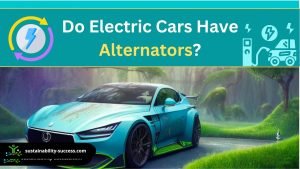As an engineer with over 15 years of experience in the automotive sector, I’m well-versed in the nuances of electric vehicles. One question that many people ask is: do electric cars have alternators?
Do Electric Cars Have Alternators?
Electric cars are powered by an electric motor instead of a combustion engine, meaning that they don’t need the traditional alternator and gas. Instead, they can use the motor as an electric generator to create electricity when the car needs to decelerate. The power is then sent to the car’s battery or used directly by other components.
Electric cars do also have other key electrical components to handle the generated power. Those include voltage regulators, inverters for the motor, and controllers for managing the energy flow and regenerative braking. These components help to ensure the electric car runs smoothly and efficiently, recovering energy whenever possible.
So, unlike Internal Combustion Engine (ICE) cars, electric vehicles don’t need an alternator, because they can simply use the electric motor to recover energy when possible.
You may also be interested in knowing why can’t electric cars charge themselves, just click the link for a specific article about that!
Overview of Internal Combustion Engines (ICEs)
The primary power source for most conventional vehicles is a combustion engine. This mechanical device uses fuel, such as gas or diesel, to create movement by burning it in small explosions inside the engine cylinders. The rotating motion created by these explosions then drives the vehicle’s wheels.
To ensure that this process runs efficiently and without fail, most combustion engines also come with alternators. As the engine turns over, the alternator charges up the car’s battery so it has enough power to operate its electrical systems, including lights and radio.
However, electric cars have their own pros and cons and are very different!
Understanding Alternators and Electric Motors
Electric motors are very different from combustion engines in that they use electricity instead of fuel. Instead of burning fuel to create energy, electric motors use stored energy from a battery pack, usually lithium-ion cells, to turn over a spinning rotor which creates rotational torque. This then drives the wheels of the vehicle.
This also means that electric cars don’t use engine oil and don’t require oil changes.
Unlike with traditional ICEs, electric cars don’t require an alternator since all their electrical components can get direct power from the battery pack. On the other hand, when the car needs to decelerate or is braking, the electric motor can simply be turned into a generator and convert kinetic energy back into electricity.
This makes electric cars much simpler compared to gas cars and helps to further improve their energy efficiency.
How to turn an electric motor into a generator?
Very simple, an electric motor and a generator are essentially built in the same way and use the same principles.
When you give power to an electric motor, the generated electromagnetic field will spin the shaft, which is connected to the wheels with a simple transmission. Therefore converting electric energy into kinetic energy.
This is also how Tesla cars work and how they can be so efficient!
Instead when you don’t give any input power to the electric motor but the car is moving, the transmission will transfer the motion back from the wheels to the shaft of the electric motor making it spin.
When the shaft of the electric motor is forced to spin, it generates electricity that can then be used by other components or stored back into the battery.
Can you install an Alternator on an Electric Car?
Some car owners may ask if it would be possible to install an alternator into an electric vehicle; however, there really isn’t much point since electric cars already recover power whenever possible through their motor/generator combo.
Why Electric Cars Don’t Use Alternators?
This wouldn’t be efficient and overall it will not generate any new power, because the alternator is only transforming kinetic energy into electricity, so it is not a power source.
This means that the power available on an EV is the energy stored in the battery pack, plus any other source like, eventually, RV solar panels on the roof (there are some concept cars with this feature).
Then the motor will be converting some of the available power into kinetic energy, allowing the car to move. However, if you install an alternator, this will simply convert some of the kinetic energy generated by the motor back in into electricity. This means that the car will go significantly slower or as an extreme case, not be able to move at all. And in any case, the alternator will always generate less power compared to the one spent to put the car in motion.
In other words, the alternator will only generate losses, because of attrition and dissipation of energy in the form of heat and vibrations. This will make the electric car much less efficient, reduce its range and performance without adding any material benefit.
In addition, it would add complexity to the system, with additional parts, weight and necessary mainteinance.
Note that if it was possible to recover all the power in an efficient way using an alternator, we would have built a perpetual motion machine, which goes agains the laws of thermodynamics.
Comparing the Cost, Efficiency, and Environmental Impact of Electric Cars and ICEs
When comparing electric cars with ICEs powered by combustible fuels such as gasoline or diesel, it’s important to take into account factors such as cost, efficiency and environmental impact. Here’s a quick summary table with the highlights of electric vs gas cars:
| Factor | Electric Cars | Gas Cars |
|---|---|---|
| Cost | Generally more expensive upfront, but cheaper to operate over time due to lower fuel and maintenance costs | Cheaper upfront, but more expensive to operate over time due to higher fuel and maintenance costs |
| Efficiency | More energy efficient, with electric motors converting most of the energy into motion and easily implemented regenerative braking | Less energy efficient, with combustion engines converting only a small percentage of energy into motion, while most of it is turned into heat. Efficiency can be improved with hybrid cars and KERS systems. |
| Environmental Impact | EV have a number of pros and cons to the environment, on the positive side, they emit no tailpipe emissions, reducing greenhouse gas emissions and improving air quality, but require electricity generation which may produce emissions depending on the source. They also require more materials and metals upfront, which also increases the emissions necessary for making the EV | Emit greenhouse gases and pollutants such as nitrogen oxides and particulate matter, contributing to air pollution |
Why Electric Cars Don’t Use Alternators
Electric cars no longer require alternators, as they operate on direct current (DC) devices like voltage regulators and inverters. These components provide constant currents at different levels of amperage for optimal efficiency. Alternating current (AC) generators are not necessary as DC components are more efficient.
Future Implications for Electric Vehicles
Electric vehicles are destined to be the future of transportation, in fact, besides cars, now there are also great electric trucks available. By replacing traditional fossil fuel-based engines with electric motors, and with the new battery tech that is being researched, hybrid and electric cars could be able to drastically reduce their environmental footprint and save drivers money in fuel costs.
But EVs are not without their downsides, including shorter range and longer charging times.
As battery technology continues to improve, however, these implications may become less of an issue. Additionally, advances of technology in motor design and other components could lead to further efficiency gains and lower price points for consumers.
Ultimately, electric vehicles are poised to revolutionize the automotive industry, making them a key part of our transport ecosystem for years to come.
FAQ
Can an alternator be used to power a Tesla battery?
A Tesla does not have a traditional alternator because it operates on electricity supplied by its battery pack. Instead, the vehicle features an AC induction motor, which is powered by alternating current generated by the inverter within the vehicle. The inverter converts the direct current (DC) from the batteries into AC current to supply power to the motor. Also, consider that overall, the car will become less efficient.
Do Teslas have a device that generates electrical power?
Tesla vehicles do not have an alternator like gas cars. Instead, they use an energy conversion system that directly converts battery power into usable energy and back.
As a quick overview, the Tesla car system is based on an induction motor, a battery pack, an inverter, a controller, and a simple transmission. The induction motor will automatically act as a generator when you take your feet off the accelerator or start braking.
This setup allows Teslas to avoid the need for a traditional alternator, increasing efficiency and reducing weight. It also reduces the cost of ownership and provides an uninterrupted power supply.
Conclusion
When it comes to electric cars, the answer to the question “do electric cars have alternators?” is a definite no. While combustion engine vehicles rely on an alternator to generate electricity, electric cars use an electric generator and various other electrical components to provide the power they need. These key components work together to ensure seamless performance and efficient energy usage.
Overall, electric cars are becoming increasingly popular due to their environmental benefits and ease of use. Without having to worry about an alternator, owners of electric vehicles can enjoy a reliable form of transport that requires very minimal maintenance. So if you’re looking for an eco-friendly option for getting around town, consider an electric car – you won’t regret it!
You may also be interested in:


